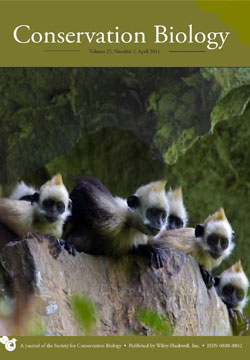The December issue of Conservation Biology features a special section edited by Li Zhang on balancing conservation and development to preserve China’s biodiversity. Find papers in this section on translocation of threatened plants, building conservation coalitions to conserve ecological interactions, orchid conservation, and more.
 |
|
White-headed langurs (Trachypithecus leucocephalus), an endemic and critically endangered species, look down from a limestone perch in Chongzuo Eco-Park. This species is confined to a narrow, 200-km2 , triangular region Guangxi Province, China. Conservation of this species and other primates in China is challenging because of their small population sizes and fragmented habitat and isolation among populations. Most of the populations of 5 endangered primates in China occur in subpopulations with unique genetic components, and gene flow between subpopulations is impeded by agriculture, roads, and human dwellings. Photo by Jed Weingarten. |
Other papers in the December issue include a study by Humair et al. that notes the high number of invasive plant species (specifically those associated with known ecological problems) versus non-invasive species sold online worldwide (free). Humair notes that automatic surveillance of sites like eBay could help reduce the movement of ecologically dangerous plants to at-risk areas. An editorial by Lundquist et al. examines how to engage the conservation community in the IPBES process, and Joshua and Elizabeth Madin write about the full extent of the global coral reef crisis.
Subscribers can log in to their SCB member home page for full access to the December issue of Conservation Biology.